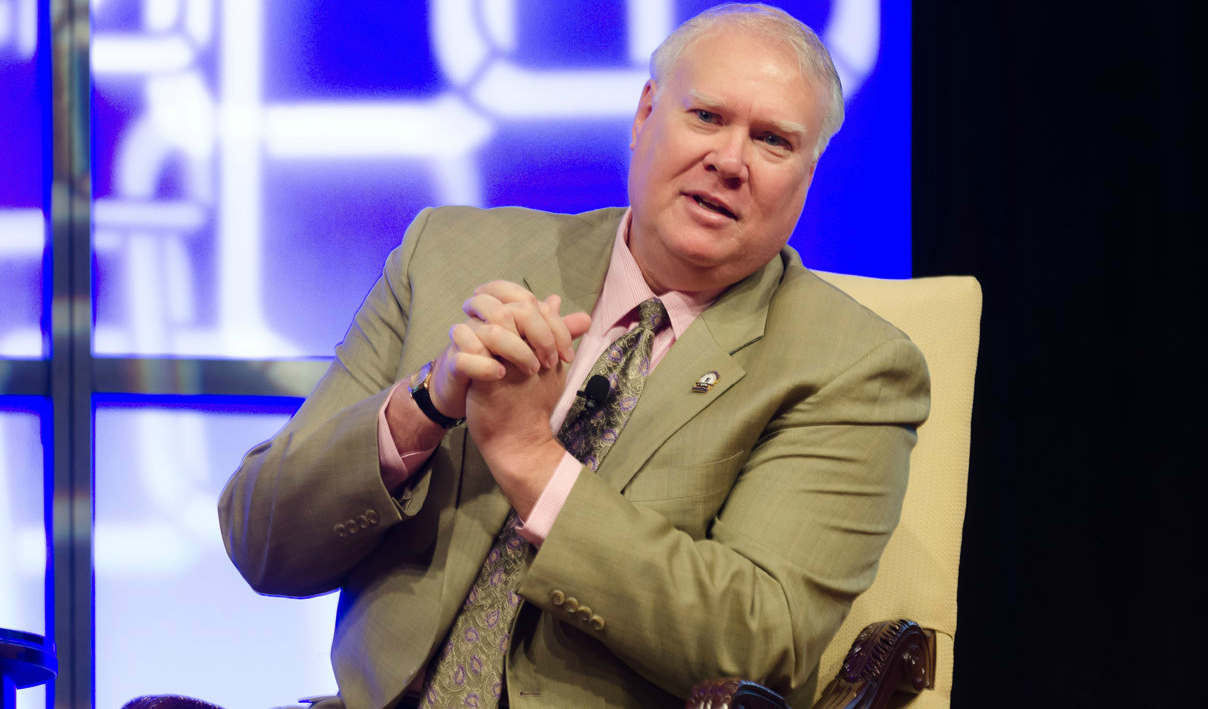
Agent-centric broker models are set up to lose and fail
Last October, I entered my 44th year as a licensed real estate agent, the last 36 of which have been as the designated broker and owner of the family’s real estate investment firm. I’m second generation. The date on my first license was barely 60 days past my 18th birthday. I aspired to be merely wet behind the ears. In those years – BA-C (Before Agent-Centric) – more business was done by less people in terms of transaction quantity than is dreamed of these days.
I was blessed (unknowingly) with the rarest of opportunities, starting from below the ground up in a hugely productive real estate company, family owned – read: Dad – and run on the Broker-Centric model. Below, the two models are defined through the lens of my experience on the inside of both.
Broker-Centric (BC) model defined
There are many factors, but the main thing is that the broker is in charge in every sense of the word. They produce the bulk of the leads, pay for them, and in many cases, design their in-house distribution. They pay for office space, and the various machines/computers necessary to do business. They don’t charge agents for much, if anything. They take virtually all of the financial risk and liability.
Commission splits in the BC model of yesteryear aren’t even believed by most modern day agents. Exclusive listings paid 20 percent of the listing side, while exclusive agency and open listings paid 15 and 10 percent respectively. The selling agent made 40 percent of the buyer side commission. There were variations of this, but the range of pay between companies was relatively narrow.
If looked at in terms of sales volume per agent, or GCI (gross commission income) if you will, the BC model requires significantly fewer agents than the Agent-Centric model requires. Adjusted for inflation, agents made more in terms of dollars than they do today at double or more the commission splits. For example, in a five year period from 1965 through 1969, just 25 to 30 full timers and eight to 12 part timers closed over 1,000 sides a year, every single year. I saw the last three in person, from the inside. The average full timer in that firm made more than twice the median household income. Twice.
Agent-Centric (AC) model defined
The AC model is, in my experience the perfect business model. That is, if you prefer the tail waggin’ the dog. It’s based upon the idea that all agents know what they’re doing and will use the time available efficiently and profitably, to their own benefit. Lead generation is typically left up to the agent.
The commission splits are typically 50 to 100 percent higher than agents toiling in a BC-based brokerage. It often requires two to five agents to equal the GCI produced by agents working under the BC model. There are exceptions, but most broker/owners employing the AC model use the mud on the wall principle. They pray that hiring the max number of agents they can house will produce the the bottom line profit they require to keep the doors open.
Brokers in the AC model often rely on newbie agents who begin with a 50 percent commission to make up for the more highly paid ‘experienced’ agents. Typically these rookies will do two or three deals in their first 6-12 months, then disappear, only to be replaced with the next rookie.
The irony of real estate teams working for an AC model firm
Note: There are kinda sorta hybrid models out there, the ones with various profit sharing and other agent-participant type models. Some are highly successful, but can’t (at least by me) be categorized as either BC or AC. I’ll leave thoughts on those outliers for others who are more informed about those models than I.
I have to believe that there are hundreds of brokerages out there who are more than a bit perplexed not only by the success of the teams they employ, but the bottom lines of the team owners. If, for example, we use the team model I ran for years, agents made a maximum of 50 percent commission split. Let’s compare that to John Doe Real Estate, a traditional company operating on the AC model, with around 50 agents. However, of those 50 agents, 10 of them, including Debbie, belong to a team owned by Debbie. Four are buyer-agents (BA), some are support staff, T/A, tech guy, team ‘manager’, etc. Debbie is a listing demon. This year, she’ll list 100 homes. Her team will close 250 sides. Fully 91 of her listings will sell and close escrow. The median price per closed side was $200,000.
The remaining 40 agents working for John’s firm closed another 280 sides, with all sides computed at three commission as a constant.
His agents make 80-90% commission splits. We’ll use an average of 80% if only to give John a fighting chance against Debbie (laugh track would be perfect here). Also, we’ll allow the median price on John’s other agent sales to be $220,000 a side, 10% higher than Debbie’s team. Let’s compare the two:
Outlining Debbie’s year:
On her 250 closed sides, here’s how Debbie did. She’s at a 90% commission split from John due to her phenomenal production.
So, 159 closed buyer sides at $200,000 median price = $954,000 GCI for the brokerage. $858,600 is Debbie’s ‘team’s’ share. Her BAs pocketed $429,300, which is an average income of six figures per BA.
Then, take 91 closed listing sides at $200,000 median price = $546,000 GCI for the brokerage. $491,400 is Debbie’s share. Debbie does all the listing and none of the selling. Furthermore, she doesn’t take referral fees from her own BAs when she gives them her own buyers.
Debbie’s take for the year after her team’s commissions are paid, comes out to $920,700. That’s before overhead of support staff, marketing, etc.
Outlining John’s year:
First, his take from Debbie’s efforts amounts to $95,400 from her buyer side transactions. Her closed listing sides netted him another $54,600. Total harvested from Debbie’s team = $150,000. But how about his other 40 agents? How did he do with them? Don’t forget, his other agents’ median closed side price was $220,000 – 10 percent higher than Debbie’s.
They closed 280 total sides. That’s a GCI of $1,848,000. John’s take from that GCI was $369,600.
Add to that his share of Debbie’s production – $150,000 – and John’s grand total comes to $519,600.
I want to tip this as much to John’s side of the table as possible, so we’re gonna assume he’s not part of a franchise operation. Therefore, he doesn’t have to shell out a percentage of every closed side to the franchise big guys. He does, however, pay for office space and the usual expenses that come with that. He has a marketing budget. With an office of 50 agents, he has a pretty sizable phone system and support staff – neither of which is free. Even if his operating expenses are the same percentage as Debbie’s (clearly a stretch to make a point) he grossed just a bit over 56 percent of what Debbie did.
The practical side
John gets a taste of 530 closed sides. Debbie gets a taste of just 47 percent of the total business done by John’s brokerage, 250 sides, yet almost doubles his gross income. Since most of John’s agents are lucky to last a year or two, he’s constantly spending time and money to replace them.
Debbie’s people? She has an impressively long waiting list to be a BA on her team. Think about it. Sure, they work very hard, but they show up looking professional, grab that day’s buyer leads, show property – follow up with the help of support staff – and make six figures. Debbie’s operating expenses, as a percentage of GCI, are lower than John’s. Duh.
The numbers really get silly when the team is under the umbrella of a ‘100% commission’ AC office. I personally know of a couple of highly successful team owners working under that system, and it’s almost like being given the key to the broker’s bank vault.
What brokerages have done for 25 years
Does this explain some of what brokerages have been doing for 25 years? Though many have been called brilliant for their forays into related vendor ownership like title, lending, escrow, etc., they did that in self defense, for Heaven’s sake. If they hadn’t done that, most would have already been face down in the water, completely forgotten.
Then, there’s the 100% commission approach. I love this one, as it’s really the brokers conceding victory to the poor caliber of agents they’ve been hiring and overpaying for the last several decades. Is it any wonder they’re failing right and left with a model that promotes the hiring of woefully unqualified, unproductive agents who will be paid roughly the same as highly qualified and productive agents? As Dad loved to ask at this point, “What genius did the math on this one?” Indeed. At least when every agent is paying the broker/owner a monthly fee for their existence, the broker makes something.
The AC model is a loser from day one
The AC model is a loser from day one and always has been. I suspect it will continue to be so. But there’s another major reason, aside from the math, that doomed the AC model before it started – the AC model violates the real life Risk vs. Reward reality.
I’ll give you a choice of two ways to go as a new agent.
- In one, you get paid 80% commission on every dollar you produce. The brokerage takes virtually all of the liability, pays all the major overhead, and provides you with a suitable office atmosphere in which to work. For the most part, you’re responsible for generating your own business. Not much, usually nothing, is handed to you in terms of business. You close business based upon your own efforts, or else you starve. Of course, you look at that $220,000 median price at three percent commission split 80/20 in your favor. Then, you say to yourself, “Self, there’s no way I won’t close less than 20 sides in a year. That’s $105,600 — I’m in!!”
- In the other scenario, you get paid 40 to 50 percent commission. You must follow strictly written protocols, do the same thing every day, be a BA, and make just 50% commission. The thing is that your buddy down the hall, the one who works as one of Debbie’s BAs, made that much and wasn’t expected to generate any business whatsoever on his own. Hmm. What to do?
Then there’s the disturbing fact that the typical agent makes only $30-something thousand per year on their own. But you’re not like those agents, right? No-sirree-Bob, you’re three times that good. Since these brokers are willing to take virtually all of the business risk, yet pay me at least 80% commission, why wouldn’t I wanna go for it? I get the best of both worlds — extraordinary pay without the commensurate risk.
And there’s the rub.
Gravity wins every time it is challenged
When we jump off a very high place without a parachute, we’re gonna die. Gravity eventually wins every time it is challenged. The same with the physics of economics. Whenever the market produces a business model challenging the laws of risk/reward, it’s as doomed to a bad ending as the guy jumping off the cliff’s edge thinking he can flap his arms and fly.
Brokers and team owners/leaders are the ones taking the risks. They should be the ones reaping the lion’s share of the profits. When brokers as a group thought they could ignore the undefeated law of risk/reward, it was akin to jumping off the cliff while flapping their arms.
Most agents simply can’t generate enough real estate business to matter. That’s not my opinion, it’s my experience since 1969.
Wanna know how feeble the typical real estate agent is? In one of California’s best years since the end of WWII, I think it was 1977, the state’s turnover rate for real estate agents was more than 2/3. If that’s not a convincing indictment of the newly installed AC model, nothing is. If you had a pulse back then, you printed $100 bills. Yet two of every three agents were either out of the business or with another broker, hoping against hope that the change of address – and not them – would make the difference.
Once and for all, let’s run from the AC model. That one change in our industry would do more to restore the public’s faith in what we do than anything else I can think of. When the vast majority of real estate agents simply don’t produce the results for which the public hires them, it’s time to reject the model creating that reality.
Jeff Brown specializes in real estate investment for retirement, has practiced real estate for over 40 years and is a veteran of over 200 tax deferred exchanges, many multi-state. Brown is a second generation broker and works daily with the third generation. With CCIM training and decades of hands on experience, Brown's expertise is highly sought after, some of which he shares on his real estate investing blog.








































Jonathan Dalton
March 18, 2013 at 9:33 pm
AC model doesn’t work at all. Unless you’re John Hall (which was around for 30-plus years before the merger), Realty One, Homesmart, etc. etc. etc.
There are no absolutes either way. The most recent examples I can think of, and the ones which I know you have in mind, failed not so much because of the split or the broker- or agent-centric model but because of a lack of business planning and dedication to success.
Jeff Brown
March 19, 2013 at 11:55 am
I think the key stat in this discussion is the empirical evidence demonstrating that the BC model not only produces more closed transactions, but with significantly few agents. That allows the brokerage a much improved bottom line, and the public benefits from an improved level of expertise and professionalism.
In the down times far more AC firms go down in flames than do the BC practitioners. This is evidenced in the higher percentage of teams using BC surviving vs in some cases, the companies for which they work.
JoeLoomer
March 19, 2013 at 12:00 pm
Jonathan, how much do you think culture played a role – if any?
Kathy Howe
March 18, 2013 at 9:54 pm
Lani, I love the article. I’m watching one broker in my area who is new with his franchise and he’s “crushing it” as Michael McClure would say. He’s close to opening another office and… let’s just say, he ascribes to the BCentric model.
Lee
March 19, 2013 at 1:53 am
A number of really good points here. A few thoughts of my own… The real losers with AC models are the consumers. With the BC model, brokers focused on the consumers as their customer and agent as “employee”, under the AC model their customer becomes the agent. Brokers must trim their expenses down so far to maintain profitability that they are forced to skimp on vital areas such as marketing and training. This could result in the consumer receiving poor advice and customer service, and limited market exposure. Also, sales people don’t make always the best business owners or leaders, but the AC model forces them to become a marketing expert, a tech expert, a team leader and an accountant. I also believe this compensation shift has kept the real estate industry behind the times in terms of technology, and innovation. Brokers/owners are the ones who should be focused on the big picture, and agents should be focused on selling and servicing their clients. The AG model removes from the broker the ability to invest in technology, and moreover the incentive to innovate at all. All that said, your numbers prove why this a very hard bell to un-ring.
JoeLoomer
March 19, 2013 at 7:46 am
“Note: There are kinda sorta hybrid models out there, the ones with various profit sharing and other agent-participant type models. Some are highly successful, but can’t (at least by me) be categorized as either BC or AC.” – I assume KW falls in this arena in your thoughts, Jeff. I would say THIS would be the future model for Brokerages, not a return/resurgence of the BC model. After all, half a billion in profit share and #1 in agent count in the country has to count for something more than just being a hybrid out there. I believe the KW model works because the central theme to virtually all the training is “lead with revenue.”
Navy Chief, Navy Pride
Jeff Brown
March 19, 2013 at 11:46 am
If I’m anything, Joe, it’s results oriented. KW is a hybrid, and their universally solid results speak for themselves. “Lead with revenue” — Let me write that one down. 🙂
Dan Desmond
March 19, 2013 at 11:12 am
The bottom 80% of agents out produce the top 20% in sales and commissions to the broker. The industry thrives on turnover because the training and products is often a second income stream. The motivating “GURUS” need them to sell their services to and NAR and affiliates need the masses for dues and to sell services to. AC real estate is a circus.
HelpUSell RealEstate
March 19, 2013 at 2:46 pm
Jeff, we couldn’t agree more. Help-U-Sell Real Estate’s business model has been broker-centric since the company’s founding in 1976. We believe that it’s the best real estate model because: 1) it’s more efficient;
2) it creates agents who have had more transactions and, therefore, more experience which enables them to better serve buyers and sellers; 3) it’s more cost-effective; 4) it creates a more manageable workload for agents; 5) brand consistency is better controlled when one person (the broker) is in charge of
all advertising and marketing. Most importantly for us, however, a broker-centric model enables our offices to offer consumers choices, ultimately saving the consumer money compared to the old-fashioned agent model. That model, while slowly fading away, seems to exist only to support the inefficiencies of that old business model. Great insight, Jeff. Thanks for sharing.
Tim White
March 20, 2013 at 2:49 pm
“It’s almost like giving the keys to the broker’s bank vault…” So true, but that;s only half the story. If you factor in all the liability that flows to the broker (insurance deductables, attorney’s fees, Franchise, MLS and Board dues (in my state the broker is responsible for collecting fees and they’re on the hook for said fees if they can’t collect), etc., etc., it makes the idea of running an AC-centric operation even more absurd. Bottom line is that the broker in this model assumes the bottom rung on the ladder (Franchise first, then agent, and then bringing up the rear is the broker). It’s sado-masochistic–but a sad reality for most brokers.
One other thing: The last time I sighted a true BC model on the east coast was pre-millenium. Can you site some examples of where these models still exist in the wild?
JAMES HARRISON
August 4, 2015 at 12:09 pm
So, 2 years after this article, how is this model doing today in a HOT market?
Lani Rosales
August 5, 2015 at 5:11 pm
James, Lani here (I'm the Editor in Chief) – I've spoken with the author and he affirms that this original editorial stands true today, even in this market.
Thanks for chiming in!
Ryan Powell
March 1, 2016 at 12:34 pm
This article is one of the most comprehensive and thorough that I’ve read on the subject. Especially like the part where you describe most models as either “Agent Centric” or “Broker Centric.”
However, 3 years later, now in 2016 it’s worth pointing out that there is actually a hybrid model I’m considering being a part of. 75-100% commission split in favor of agent, $129 monthly fee all inclusive (no transaction fees, software fees, vendor fees, insurance costs etc) plus buyer and seller leads on demand. Firm is called Mont Sky Real Estate in NYC … have included their recruitment site below.
Best of luck and thanks for the article again.
Pingback: Real Estate Agent Vs Insurance Broker | ToRealestate